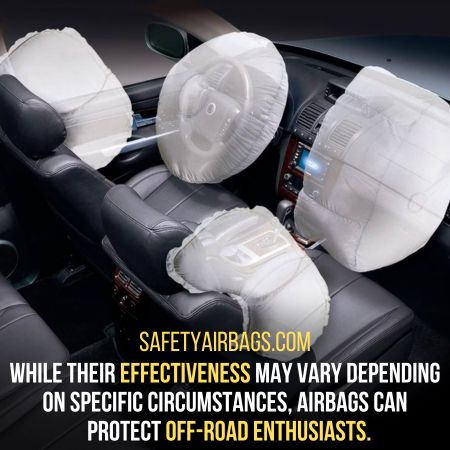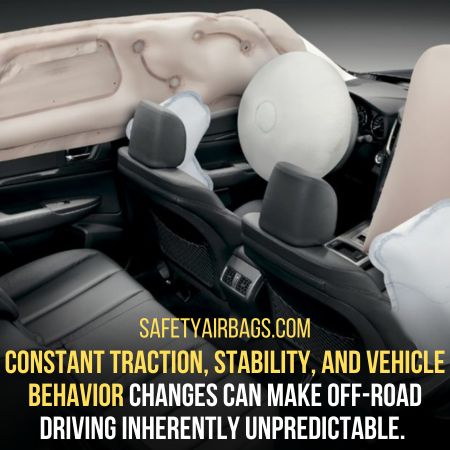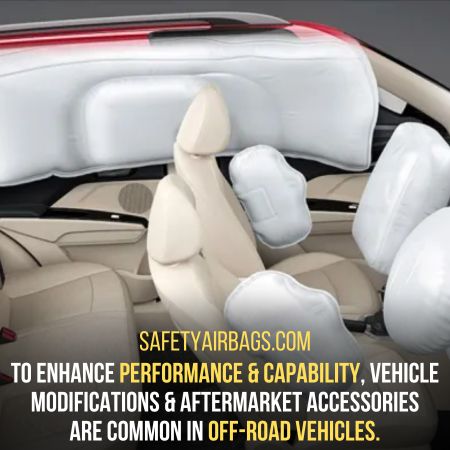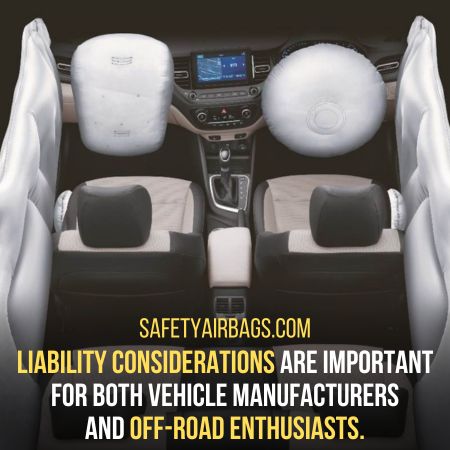Off-road environments pose unique challenges and hazards requiring special vehicle safety attention.
What Will I learn
- 1 Significance of airbags in overall vehicle safety
- 2 Understanding Airbags and Their Function
- 3 Off-Road Challenges and Considerations
- 4 Effectiveness of Airbags in Off-Road Environments
- 5 Limitations and Considerations for Off-Road Airbag Deployment
- 6 Alternative Safety Measures for Off-Road Vehicles
- 7 Manufacturer Recommendations and Regulations
- 8 Conclusion:
Ensuring vehicle safety in these environments is paramount to protect both the occupants and the vehicle itself.
Significance of airbags in overall vehicle safety
Airbags play a crucial role in enhancing overall vehicle safety.
They are designed to inflate rapidly during a collision, creating a protective cushion between the occupants and the vehicle’s interior components.

Airbags can help mitigate injuries, particularly in frontal collisions, by reducing the force of impact on the occupants.
Their widespread adoption in passenger vehicles has demonstrated their effectiveness in saving lives and reducing the severity of injuries.
Are airbags good for off-road use?
The effectiveness of airbags in off-road scenarios is a subject of exploration.
Off-road environments present unique challenges that differ from on-road conditions, including uneven terrains, sudden jolts, and unpredictable impacts.
While their effectiveness may vary depending on the specific circumstances, airbags can still protect off-road enthusiasts.
Understanding Airbags and Their Function
Airbags are part of a vehicle’s supplemental restraint system (SRS), typically located in the steering wheel, dashboard, and side panels.
In the event of a collision, crash sensors detect the impact and send a signal to the airbag control module, which triggers the deployment of the airbags.
The airbags rapidly inflate with gas, creating a cushioning barrier between the occupants and the vehicle’s hard surfaces, thus reducing the risk of severe injuries.
Role of airbags in reducing injuries in various types of accidents
Airbags are specifically designed to mitigate injuries in different types of accidents, including frontal collisions, side impacts, and rollovers.
Airbags primarily protect the occupants‘ head, chest, and upper body in frontal collisions.
They reduce the risk of severe injuries caused by contact with the steering wheel, dashboard, or windshield.
Additionally, side and curtain airbags protect against side impacts and rollovers by preventing occupants’ heads from striking the vehicle’s interior components.
Airbags offer benefits in various driving conditions, including off-road scenarios.
When sudden impacts or collisions occur, such as hitting a large obstacle or landing after a jump, airbags can help absorb and distribute the forces exerted on the occupants, reducing the risk of severe injuries.
Off-Road Challenges and Considerations
Off-road environments present a range of unique characteristics and hazards that pose challenges to vehicle safety.
These may include rough and uneven terrains, loose surfaces, steep inclines, deep water crossings, and exposure to rocks, trees, and other obstacles.
Understanding these challenges is essential in evaluating the effectiveness of airbags in off-road situations.
1. Impact of terrain variations on vehicle dynamics and occupant safety
The variations in terrain encountered in off-road environments significantly impact vehicle dynamics and occupant safety.
Constant traction, stability, and vehicle behavior changes can make off-road driving inherently unpredictable.
The effectiveness of airbags may be influenced by the specific terrain encountered, such as soft sand, mud, or gravel, as these surfaces can affect the vehicle’s motion and the resulting forces exerted during a collision.
2. Factors influencing the effectiveness of airbags in off-road scenarios
Several factors can influence the effectiveness of airbags in off-road scenarios.
These include:
– The speed and angle of impact
– The presence of other safety features in the vehicle
– The occupants’ seatbelt usage
– The occupants’ position and proximity to the airbag deployment zones.
Additionally, aftermarket modifications or accessories, such as bull bars or winches, may affect the deployment and performance of airbags in off-road situations.
Effectiveness of Airbags in Off-Road Environments
Assessing the effectiveness of airbags in off-road accidents requires a comprehensive examination of real-world data, crash tests, and simulations.
Off-road driving often involves rough terrains, uneven surfaces, and unpredictable conditions.
In such situations, airbags can still play a crucial role in reducing the severity of injuries.
They protect by rapidly inflating to cushion the occupants during a collision or impact, helping to prevent direct contact with the vehicle’s interior surfaces or objects.
However, it is important to note that various factors can influence the effectiveness of airbags in off-road environments.
These include the type of off-road vehicle, driving speed, terrain conditions, and the nature of the collision.

Off-road vehicles like SUVs and trucks are typically equipped with more robust suspensions and higher ground clearance.
They can help absorb some impacts and reduce the need for airbag deployment.
Additionally, certain off-road situations, such as extreme inclines, sudden drops, or driving at high speeds over rough terrain, may pose unique challenges for airbags.
The deployment of airbags in these scenarios may be delayed or affected by the vehicle’s inclination sensors or other safety systems/
This prioritizes the stability and control of the vehicle. Despite these considerations, airbags remain a valuable safety feature in off-road environments.
They can help mitigate the risk of serious injuries and provide additional protection for occupants.
However, off-road enthusiasts must drive responsibly, adhere to safety guidelines, and understand the limitations of airbags in extreme off-road conditions.
Limitations and Considerations for Off-Road Airbag Deployment
Deploying airbags in off-road environments can present challenges due to uneven or unstable terrain.
When the vehicle is at an extreme angle or encounters rough surfaces, the deployment of airbags may be hindered or delayed.
It is essential to consider these challenges to ensure that airbags can effectively deploy and provide the intended protection to occupants.
1. Impact of vehicle modifications and aftermarket accessories on airbag functionality
To enhance performance and capability, vehicle modifications and aftermarket accessories are common in off-road vehicles.
However, these modifications can potentially impact airbag functionality.

For instance, aftermarket bull bars or other front-end accessories may interfere with properly deploying frontal airbags.
Vehicle owners and manufacturers must consider the compatibility of modifications with airbag systems to maintain their effectiveness.
2. Importance of proper seatbelt usage and seating position in off-road scenarios
While airbags provide an additional layer of protection, their effectiveness is greatly enhanced when used with seatbelts.
Proper seatbelt usage and correct seating positions play a critical role in maximizing the effectiveness of airbags.
Occupants should always wear seatbelts and adjust their seating positions according to the manufacturer’s recommendations.
This can ensure airbags’ optimal deployment and performance in off-road scenarios.
Alternative Safety Measures for Off-Road Vehicles
In addition to airbags, off-road vehicles often incorporate specific safety features and technologies designed to enhance occupant protection in rugged environments.
These may include reinforced frames, roll bars, skid plates, and underbody protection to safeguard against impacts and provide structural integrity.
Additionally, off-road vehicles may have specialized traction control systems, off-road-specific stability programs, and advanced driver assistance systems tailored to off-road conditions.
Manufacturer Recommendations and Regulations
Vehicle manufacturers often provide specific guidelines and recommendations regarding the usage of airbags in off-road conditions.
These guidelines may include information about airbag deployment limitations, seatbelt usage recommendations, and instructions on proper seating positions.
Off-road enthusiasts need to familiarize themselves with these guidelines to ensure the safe operation of their vehicles.
1. Regulatory standards and requirements for airbags in off-road vehicles:
Regulatory standards and requirements play a significant role in ensuring the safety of airbags in off-road vehicles.
Regulatory bodies establish standards for airbag performance, deployment thresholds, and testing procedures.
Off-road vehicle manufacturers must comply with these standards to ensure airbags meet the safety requirements for off-road use.
2. Liability considerations for vehicle manufacturers and airbag deployment in off-road accidents:
Liability considerations are important for both vehicle manufacturers and off-road enthusiasts.

Manufacturers must ensure that their vehicles and airbag systems meet safety standards and perform as intended.
In off-road accidents where airbags are deployed, liability may arise if modifications or aftermarket accessories interfere with the airbag’s functionality.
Off-road drivers should know the potential implications of modifications on vehicle safety and seek professional guidance when changing their vehicles.
Conclusion:
In conclusion, airbags offer significant benefits in off-road use by providing additional protection to vehicle occupants.
They have effectively reduced injuries in various accidents, including those encountered off-road.
However, certain limitations and considerations must be considered to ensure their optimal performance in off-road scenarios.
While the effectiveness of airbags in off-road accidents may vary depending on the specific circumstances, available data, case studies, and real-world examples indicate that they can provide valuable protection in off-road scenarios.
Further research and advancements in vehicle design, crash testing, and occupant safety systems are continuously improving the effectiveness of airbags in off-road use.
